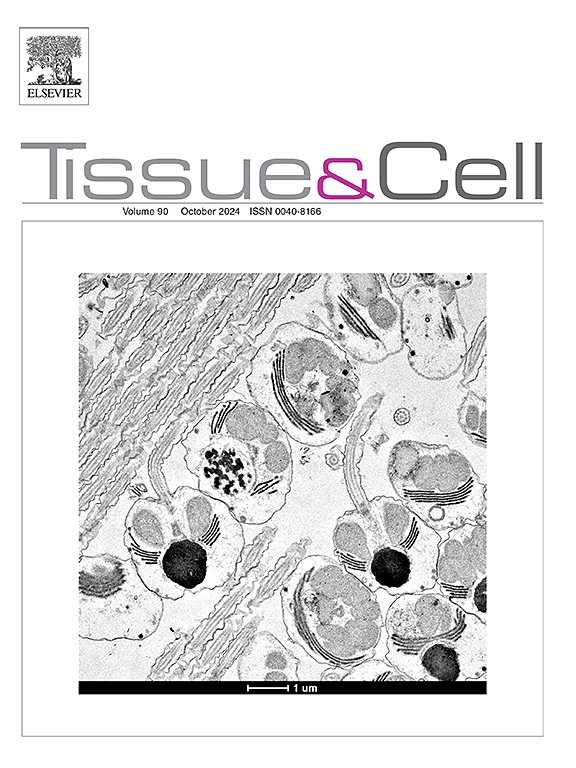Resveratrol-loaded nanofibrous scaffolds combined with menstrual blood stem cells for bone healing applications
IF 2.7
4区 生物学
Q1 ANATOMY & MORPHOLOGY
引用次数: 0
Abstract
In the field of regenerative medicine, bone tissue engineering has emerged as a promising strategy for addressing bone defects and injuries. A key aspect of this field is the development of biomimetic scaffolds that replicate the intricate architecture of native bone tissue, creating an environment conducive to cellular attachment, proliferation, and differentiation. In this study, we developed a novel resveratrol-loaded nanofibrous collagen/polycaprolactone (PCL) scaffold designed to serve as a delivery system for menstrual blood stem cells (MenSCs) to enhance bone healing. This innovative approach integrates the osteogenic, anti-inflammatory, and antioxidant properties of resveratrol with the multipotency and immunomodulatory effects of MenSCs, creating a dual-functional system that enhances bone regeneration, angiogenesis, and immune modulation. The scaffolds were extensively characterized in vitro, evaluating their microarchitecture, biological properties, hemocompatibility, radical scavenging potential, and anti-inflammatory activity. They were then implanted into a rat model with calvarial bone defects to assess their regenerative potential. Our findings indicate that the scaffolds exhibited no cytotoxicity toward MG-63 cells and demonstrated significant anti-inflammatory activity in vitro. In vivo assessments further revealed that scaffolds loaded with resveratrol and MenSCs promoted bone healing by enhancing collagen deposition and new bone formation. Moreover, gene expression analysis showed upregulation of type I collagen, b-FGF, and VEGFa, while TNF-α expression was downregulated, indicating an improved osteogenic and immunomodulatory response. In conclusion, our study highlights the potential of resveratrol-loaded, MenSCs-seeded scaffolds as a cutting-edge, biomimetic strategy for bone regeneration, offering a novel cell- and drug-based platform for advancing bone tissue engineering and regenerative medicine.
白藜芦醇负载纳米纤维支架结合经血干细胞用于骨愈合应用
在再生医学领域,骨组织工程已成为解决骨缺损和骨损伤的一种有前途的策略。该领域的一个关键方面是仿生支架的发展,这种支架可以复制天然骨组织的复杂结构,创造有利于细胞附着、增殖和分化的环境。在这项研究中,我们开发了一种新型的白藜芦醇负载纳米纤维胶原/聚己内酯(PCL)支架,设计用于作为经血干细胞(MenSCs)的递送系统,以促进骨愈合。这种创新的方法将白藜芦醇的成骨、抗炎和抗氧化特性与MenSCs的多能性和免疫调节作用结合在一起,创造了一个双重功能的系统,可以增强骨再生、血管生成和免疫调节。在体外对这些支架进行了广泛的表征,评估了它们的微结构、生物学特性、血液相容性、自由基清除潜力和抗炎活性。然后将它们植入有颅骨骨缺损的大鼠模型中,以评估它们的再生潜力。我们的研究结果表明,支架对MG-63细胞没有细胞毒性,并且在体外表现出明显的抗炎活性。体内评估进一步显示,装载白藜芦醇和MenSCs的支架通过增强胶原沉积和新骨形成来促进骨愈合。此外,基因表达分析显示I型胶原、b-FGF和VEGFa表达上调,而TNF-α表达下调,表明成骨和免疫调节反应得到改善。总之,我们的研究强调了白藜芦醇负载、menscs种子支架作为一种尖端的仿生骨再生策略的潜力,为推进骨组织工程和再生医学提供了一个新的细胞和药物平台。
本文章由计算机程序翻译,如有差异,请以英文原文为准。
求助全文
约1分钟内获得全文
求助全文
来源期刊

Tissue & cell
医学-解剖学与形态学
CiteScore
3.90
自引率
0.00%
发文量
234
期刊介绍:
Tissue and Cell is devoted to original research on the organization of cells, subcellular and extracellular components at all levels, including the grouping and interrelations of cells in tissues and organs. The journal encourages submission of ultrastructural studies that provide novel insights into structure, function and physiology of cells and tissues, in health and disease. Bioengineering and stem cells studies focused on the description of morphological and/or histological data are also welcomed.
Studies investigating the effect of compounds and/or substances on structure of cells and tissues are generally outside the scope of this journal. For consideration, studies should contain a clear rationale on the use of (a) given substance(s), have a compelling morphological and structural focus and present novel incremental findings from previous literature.
 求助内容:
求助内容: 应助结果提醒方式:
应助结果提醒方式:


